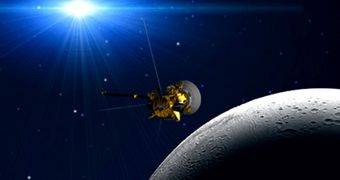Experts at the American space agency announce that they were successful in restoring all functionality to the Cassini spacecraft, which was affected by a computer glitch on November 2.
The malfunction, which was most likely owed to a solar storm damaging a data transmission coming from Earth, forced its computers into a protective state known as a safe-mode.
All science payloads were shut down, and the probe only retained altitude and propulsion control. Luckily, mission managers were able to identify the root cause of the problem, and then develop solutions to counteract it.
According to experts at the NASA Jet Propulsion Laboratory (JPL), in Pasadena, California, the fact that Cassini's computers shut down was a real misfortune. The destroyed data made their way into one of the few locations that was sensitive to damage.
Fortunately, the safe mode prevented any sort of additional damage to the scientific instrumentation. This allowed the JPL crew to gradually restore functionalities, after they uploaded new commands to replace the ones that were damaged during transmissions.
Since a few days after the safe mode began, they have been saying that the spacecraft will resume its science mission on November 24, and this is precisely what happened. Yesterday, the probe was brought back online.
Unfortunately, during these weeks that it was out of it, the probe missed a flyby of Saturn's largest moon, Titan. But mission managers are not upset – Cassini will remain at Jupiter until at least 2017, and dozens of flybys are still to come.
On the bright side of things, the NASA orbiter was put back online just in time to conduct two flybys of the moon Enceladus, which has captured the imagination of astronomers ever since they learned that it features geysers at its South Pole.
The landscape features are located among tiger stripe-like formations, and they have been demonstrated to emit organic particles and water/ice vapors. It is now believed that a liquid ocean is powering the moon's interior.
During the two new flybys, which will take place on November 30 and December 21 respectively, will be focused on making more sense of the inner structure Enceladus has.
Cassini will use its radio science payloads exclusively, to determine slight variations in the moon's gravitational pull, that may be indicative of what lies beneath.
Both flybys will take the spacecraft about 50 kilometers (30 miles) above the surface, which is tremendously close. But this maneuver will also ensure the most accurate readings.

 14 DAY TRIAL //
14 DAY TRIAL //